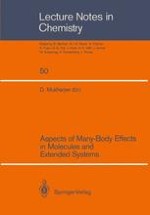1989 | Buch
Aspects of Many-Body Effects in Molecules and Extended Systems
Proceedings of the Workshop-Cum-Symposium Held in Calcutta, February 1–10, 1988
herausgegeben von: D. Mukherjee
Verlag: Springer Berlin Heidelberg
Buchreihe : Lecture Notes in Chemistry
Enthalten in: Professional Book Archive
